George Cruikshank. In the end, Dickens self-financed the publication, broke with his publishers--those sticks in the mud who wanted a more or less chapbook affair--and left his story and us much the richer.
In the event, only two of Leech's illustrations were suggestive of that social message, one obliquely, one overtly. Four were in color; four were in black and white, but they all have an offbeat charm. One was used for the frontispiece of the book: a depiction of Old Fezziwig--to whom Scrooge was, in his youth, apprenticed--and his wife, standing forth to lead the ball guests in "Sir Roger de Coverley" (which we here in the States know as a Virginia reel).
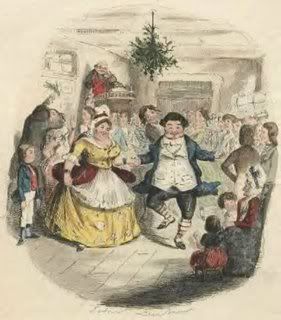
Leech perfectly captures the chubby, kindly couple of Scrooge's memory, but others in the series are deliciously eerie. Take, for example, the color etching of Marley's entrance and the scene outside the window through which Marley departs, after warning Scrooge he will be visited by the three spirits.
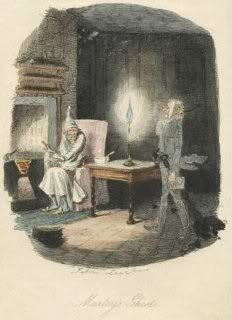
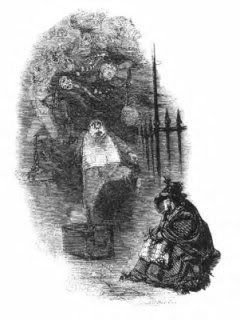
Marley, even in a caricature style, gives one a shiver, with his thin transparence; the scene outside the window, foreshadowing the fate that awaits Scrooge should he not reform, is more overt, with the ghosts wailing over the heads of the homeless woman and her child, on the stoop below.
Scrooge is, of course, a tough nut to crack; if he weren't, then we wouldn't have a story. But he is disquieted enough by the memories roused by the Ghost of Christmas Past ("Long past?" "No. Your past.") that he tries to put out its light, in a little drawing that reminds me no end of a candle being snuffed:
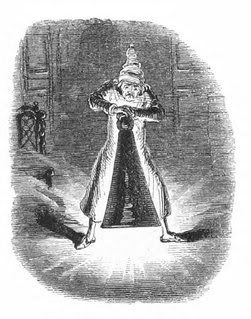
Scrooge's encounter with the Ghost of Christmas Present, beginning as it does in an all-but-unrecognizable decorated version of his own miserly apartment, is done in bright, uproarious colors, only appropriate for a spirit whose mission is to spread joy and peace:
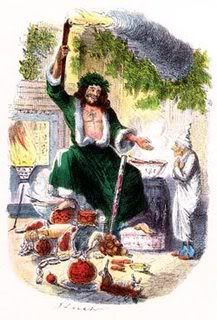
But even this spirit, grand and jolly though he may be, has hidden a reminder of the poverty and degradation that most societies try to forget: the skinny, dreadful children named Ignorance and Want, before whom Scrooge quails, then begs the spirit to cover them.

Hard upon this horrifying vision comes the most frightening of all the spirits Scrooge has encountered on this night of many wonders: the Ghost of Christmas Yet to Come, who by his very eloquent silence terrifies Scrooge into a realization of the fate Marley hoped to spare him.
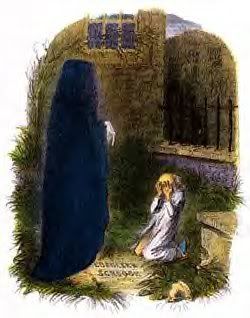
That all but skeletal hand, pointing Scrooge onward toward a miser's grave, does more than all the other spirits combined to convince Scrooge to mend his ways.
Leech's illustrations end, as does Dickens's story, with Scrooge sitting down over a wassail bowl with his long-suffering clerk, Bob Cratchit, to discuss ways in which Scrooge may help Cratchit's family.
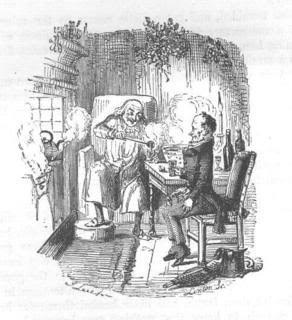
Other artists over the years have illustrated A CHRISTMAS CAROL more lavishly and copiously--among them Arthur Rackham, whose 1915 edition turns the whole book into a delightfully spooky fairyland. No one, however, has ever captured the lessons of the spirits with quite John Leech's elan; his arresting little set pieces remain one of the pleasures of this little book, and are available in any number of facsimile additions.
And as Tiny Tim observed (it's worth repeating, this time of year!), God bless us, every one!

Odds Bodkins.....and gadzooks as well......lol....thanks for the background.,,,,,
ReplyDeleteHi, Sturg--most welcome! I found out the other day in an article in the NY TIMES, BTW, the original color etching of the Ghost of Christmas Present had to be redone because Leech did the Ghost's robe in red, and the text specifically says it's green--Fun little book and I had a lot of fun researching this, too--Good to hear from you!
ReplyDeleteGreat story about illustrated Dickens. Last year I used the musical Scrooge because of the number featuring the Fezziwigs
ReplyDeleteDecember The 25th
Hi Jamie--those illustrations have always been part of the reason I love A CHRISTMAS CAROL best of all Dickens's works--(well, that and the ghosts ;)). I first saw them years ago when my grandmother bought us a facsimile edition at a Save the Children store here in town, a tiny red-backed book with microscopic print and the title stamped in gold on the cover. It also included a separate book that had information about the book's genesis, layout, publication and illustrations--stuff I was interested in so I remember them--:D
ReplyDelete